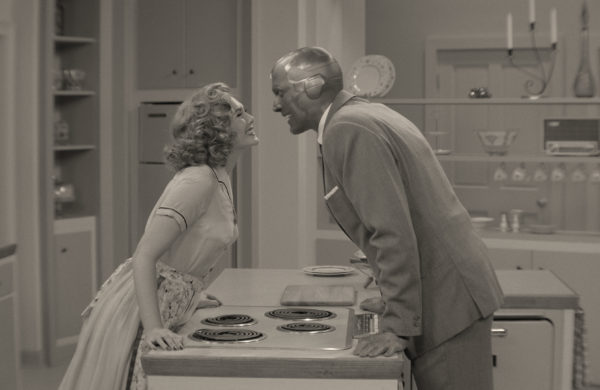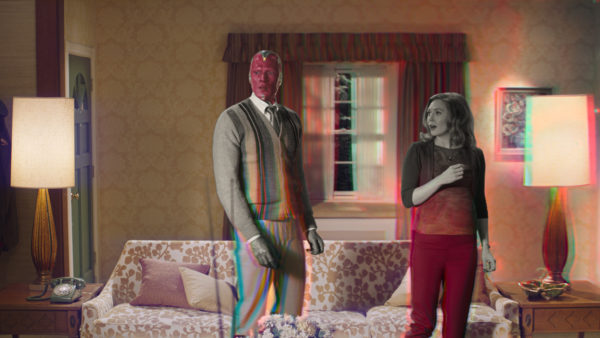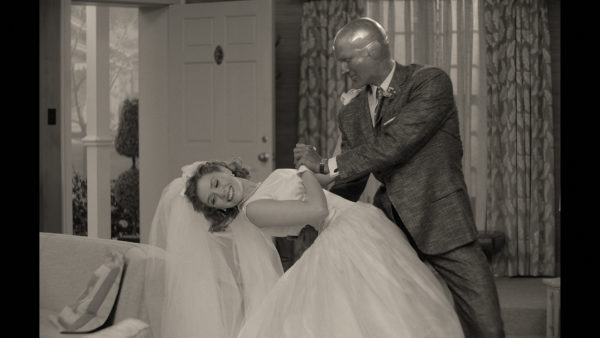
The first new entry in the MCU following Avengers: Endgame hits Disney+, but the format and vibe is unlike anything we’ve seen in the Marvel universe.
WandaVision was intended to be the second Marvel TV series to debut on Disney+, but due to scheduling delays on The Falcon and The Winter Soldier, the Matt Shakman series is the first MCU series to arrive. It does so with a bevy of anticipation.
What audiences may not be expecting is how unorthodox the series is. Ads and promos have teased Wanda Maximoff (Elizabeth Olsen) and Vision (Paul Bethany) living in suburban bliss informed by a variety of classic American sitcoms such as Bewitched, The Dick Van Dyke Show, The Brady Bunch and I Love Lucy.
What’s fascinating is that the show isn’t simply modelled on these nostalgic titles; it is presented as its own time-specific property to be consumed by viewers, literally starring Wanda and Vision (not Olsen and Bethany) and filmed in front of a live studio audience.
This results in a broad, retro-infused dose of nostalgia that will undoubtedly be catnip to audiences of a certain age and/or those familiar with the conventions and tropes of classic TV.
As a production, everything is pitch perfect. The set design, costuming and hair changes each episode to reflect the change in not only decade, but the signature show it is aping. A great deal of attention has been paid to authentically reproduce the experience of watching these series and there’s a sense of wholesome fun, whimsy and quaint charm in these early episodes (I’ve seen three of nine).

Unfortunately, what’s missing is a compulsion to continue watching. The plot is relatively straightforward: two superheroes move into a suburban neighbourhood and attempt to blend in by performing innocuous tasks such as participating in a charity fundraiser or hosting Vision’s new boss for a dinner. Because of the nature of the series that WandaVision takes its cues from, the stakes are often low. In the first episode a comedy of errors about an important date results in Wanda using her magic to make dinner on the fly to disastrous result. In the second Vision inadvertently uses his robotic powers in front of neighbours at a magic show.
It’s light hearted and frequently fun, but even at just under 30 minutes, the narrative feel a little bland and stretched. In each episode, there are brief hints that something is not quite right in Westview, but early on this never amounts to more than a mild tease.
Disney+’s decision to release new episodes weekly is the result of the recent success of The Mandalorian, which made sense for that show because each episode had plenty of hooks and compelling story beats. Comparatively, in WandaVision there’s simply not enough happening in any one episode, particularly once the amusement of the latest homage wears off.
While this makes sense from a marketing perspective as it will keep the show in the popular consciousness for eight weeks, the format of WandaVision is far better suited for binge watching (or, at the very least, in larger batches than one or two episodes at a time).

Thankfully the performances are plenty entertaining. Bethany is very much up to the task of playing the befuddled husband of yore, while Kathyrn Hahn frequently parachutes in to provide some expert comedic support. For my money, though, it’s Olsen who is doing the series’ heavy-lifting, particularly when it comes to WandaVision’s emotional components. This is most apparent in episode three, where it becomes clear that this fictitious, time-hopping purgatory is centered around Wanda.
Bottom Line: WandaVision is a unique and unorthodox entry in the Marvel Universe. Its greatest strength – and simultaneous weakness for a certain type of Marvel fan – is that it isn’t catering to the perception of what to expect from a superhero property. Overall, this is an ambitious and experimental series that, should it nail its big reveal(s) down the line, could portend a brave new direction for future superhero adventures.
WandaVision airs Fridays on Disney+